Books have the power to transport us to far-off lands and distant times. They can take us on a journey to a place we have never been before and to a culture that is foreign to us. With books, we can explore the history, culture, and beauty of a place without ever leaving the comfort of our own homes. But books can also make you want to travel, go beyond the narrative, and hop on the next plane.
Here you will have several reasons to increase your to-read list, but also very good reasons to pack your bags and make your way to Portugal.
300 Days of Sun – Deborah Lawrenson
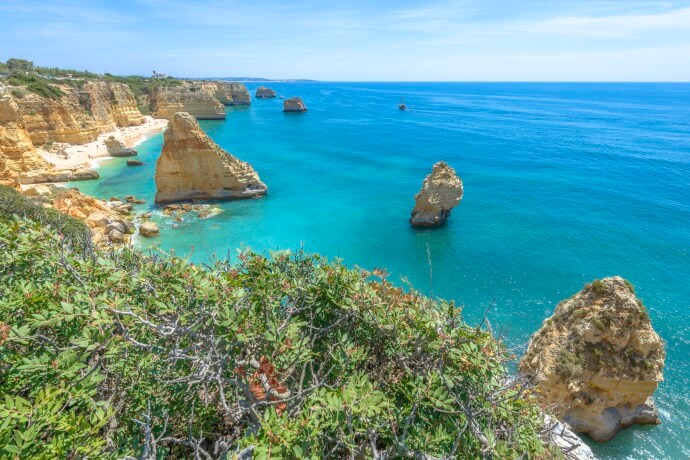
Deborah Lawrenson's novel takes you to a beautiful Portuguese town with a troubled past. Journalist Joanna Millard travels to Faro to escape a stagnant career and relationship. However, the charming town has a dark side, as corruption and wartime spoils have compromised its economy. Nathan Emberlin, a charismatic young man, seeks Joanna's company to uncover the truth about a child's kidnapping decades prior. Her search leads her to Ian Rylands, who believes the answers lie within a novel written by American Esta Hartford. As Joanna delves deeper into the book, she suspects that the past may still pose a present danger in Faro.
The narrative takes place in this lovely town located on the picturesque southern coast of Portugal, in the Algarve region. Known for its endless sunshine, as the book's title suggests, this idyllic town is a true jewel that boasts pleasant weather throughout the year. Its cobbled streets wind through the remnants of Moorish architecture, the walls of which tell tales of a bygone era. The views of the ocean from Faro's seaside promenade are nothing short of breathtaking, offering an expanse of blue that stretches out toward the horizon. Its charm is bewitching, a quality that draws plenty of visitors every year.
Faro has a quaint historic center that has several notable landmarks, including the Arco da Vila, a gate that dates back to the Roman era, and the Bishop's Palace, a 16th-century architectural masterpiece. Nevertheless, the city is home to other important highlights as well, including the Faro Cathedral, an impressive edifice constructed in the 13th century featuring a blend of Gothic and Renaissance styles, and the Ria Formosa Natural Park, a protected wetland area and a popular destination for birdwatching, hiking, and biking. This stunning and biodiverse nature reserve is known for its unique array of ecosystems, comprising lagoons, salt pans, dunes, marshes, and islands. One of the highlights is its beautiful beaches, which are known for their golden sand and crystal-clear waters – it is a nature lovers’ paradise!
In Faro, you can spend the day soaking up the warm sun rays at the wide Praia do Farol, backed by sand dunes and protected by wooden walkways, the long Praia da Barreta, also known as Ilha Deserta, which is a pristine and unspoiled beach known for its natural beauty, seclusion, and tranquility, among many others.
So, be sure to take the opportunity to explore the amazing location that serves as the captivating backdrop for this book – it is the perfect setting for this intriguing narrative, but it is also worth visiting and exploring on its own merits!
City and the Mountains – Eça de Queiroz
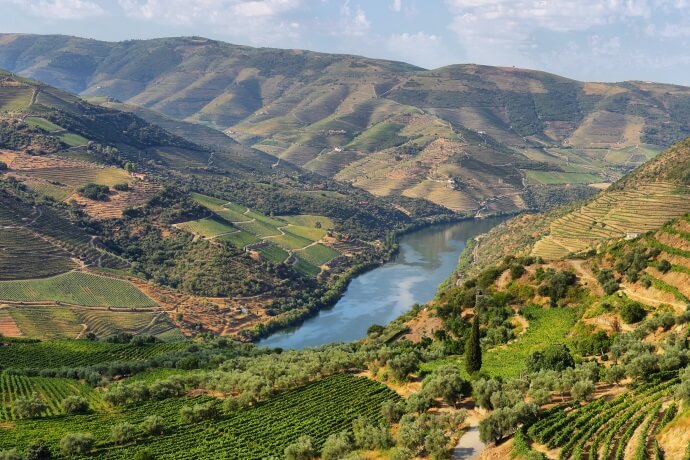
This incredibly funny novel full of joy celebrates country life while somehow criticizing modern city life. The main character, Jacinto, is a bored heir to a large estate in Portugal who has never been to the country. When he receives a letter from his estate manager about moving the bones of his ancestors to a renovated chapel, he decides to visit. He travels to Portugal with his friend and experiences the joys of simple country life, which completely changes their lives.
The writer of this novel, Eça de Queiroz, is a famous Portuguese writer born in 1845. He grew up in a family with liberal ideals, which influenced his writing, and was known for his unique writing style and language. He is definitely one of the most important names in Portuguese literature.
The narrative unfolds in the Douro region, a land of enchantment, brimming with centuries of history and culture that has matured into one of the world's most renowned wine destinations – it is easy to see why those characters fell in love with the countryside while visiting this idyllic UNESCO World Heritage Site! Tucked away in the northern reaches of Portugal, this breathtaking region spans 250 km of the dramatic and winding Douro River Valley, dotted with terraced vineyards that climb high up the hillsides. Here, amidst the steep inclines and sleepy storybook villages, you are transported to a world where time slows down and the wine flows freely! The Douro Valley produces some of the world's most exquisite wines, including the famous port wine, made exclusively in this charming valley. In fact, this is the oldest demarcated wine region in the world. With vineyard tours, wine tastings, and a hearty dose of the local cuisine, there's no better way to experience the best that Portugal has to offer than in the striking and unforgettable Douro region.
The Douro Valley is home to many beautiful cities and villages, but there are some that stand out as must-see destinations. Pinhão, for instance, is considered to be the heart of the valley due to its historic estates and iconic railway station, famous for its stunning hand-painted tiles that give off an authentic Portuguese vibe. Visitors can also explore the secrets of Port wine in the numerous wineries and estates located in the area. Peso da Régua, known as the capital of wine, offers amazing landscapes of vineyards, popular quintas, and impressive viewpoints. Lamego is another city worth visiting for its rich history, monumental architecture, and delicious gastronomy. Nevertheless, the schist villages like São Xisto, Gondarem or Midões, are a natural beauty to behold as well.
La donna delle Azzorre (The Flying Island) – Romana Petri
%20%E2%80%93%20Romana%20Petri.jpg?width=690&height=460&name=La%20donna%20delle%20azzorre%20(The%20Flying%20Island)%20%E2%80%93%20Romana%20Petri.jpg)
This interesting book is about an Italian woman's experience living on the Azores, a Portuguese archipelago in the Atlantic Ocean. The islanders are depicted as having a culture that is a mix of traditional beliefs and modern influences brought in by returning workers who view the Azores as a holiday destination rather than a home. On one hand, they have a natural philosophy of kindness and modesty, with plenty of traditions and a very unique culture. On the other hand, there is a new American culture being imported, characterized as a brute realism that consists of new cultural influences. The author highlights the threat posed by the encroachment of an alien culture that is fast-consuming the natural and social world, which turns the book into a blend of lyrical fantasy and a more serious social analysis.
The backdrop of this narrative is the beautiful Azores archipelago, a breathtakingly beautiful cluster of nine volcanic islands nestled in the middle of the vast Atlantic Ocean, roughly 1500 kilometers west of mainland Portugal. The rugged coastlines, rolling green hills, and dramatic mountains are nothing short of staggering, a testament to the sheer power of nature. The islands are veritable treasure troves of unique flora and fauna, boasting numerous endemic species that are found nowhere else on Earth. Beyond the natural beauty, the Azores boasts a rich cultural heritage that blends Portuguese traditions with the influence of the sea and the isolation of island life. The locals are renowned for their warmth and hospitality, and you can expect to bask in the relaxed, peaceful atmosphere of the islands, the perfect escape from the chaos of city life.
There are so many stunning attractions to discover in the Azores, that the difficulty lies in choosing from the vast panoply. Breathtaking waterfalls cascading down verdant cliffs provide an unforgettable sight, outstanding lagoons surrounded by nature, such as the two famous lagoons in Sete Cidades, S. Miguel, and amazing boiling springs and hot thermal baths that offer an unparalleled relaxation experience are just some of the distinctive highlights. Additionally, São Jorge's charming fajãs, a unique geographic feature, provide picturesque scenery of lush greenery and crystal-clear waters. For food lovers, the Azores offers a gastronomic feast, boasting a mouthwatering cuisine that combines traditional Portuguese dishes with fresh seafood and locally grown produce. The renowned dish called “cozido” originates from the Azores and is a scrumptious meal. The islands' strong connection to the sea is also evident in every aspect of daily life, including the cuisine. Unique natural monuments can also be found throughout the Azores, showcasing the raw beauty and power of nature. The island of S. Miguel is the biggest and most popular island of the archipelago and is considered by many to be the most beautiful one as well.
The Mystery of the Sintra Road - Eça de Queiroz

In this satirical mystery story, two friends are kidnapped by well-mannered masked men who claim to need a doctor to assist a noblewoman in labor. However, when they arrive at the house, they discover a dead man instead. A.M.C., an unknown man, enters the scene and states that the man died from opium poisoning. The doctor writes a letter to a newspaper editor detailing what he knows, which is later contradicted by A.M.C.'s friend and one of the masked men. Eça de Queiroz wrote this story with Ramalho Ortigão in 1870, publishing it anonymously as a series of letters. This amusing and engaging novel showcases Eça's early skill as a novelist and has been adapted into a Portuguese feature film.
This story is set in the town of Sintra, and the narrative portrays the town's landscapes, architecture, and inhabitants in great detail, which makes this book the perfect read for the ones who want to get to know a little more about this enchanting village before visiting!
Sintra is undoubtedly a romantic destination, with its enchanting mystique, sometimes foggy air, lush greenery covering the mountains and manor houses walls, and fairy-tale palaces. Walking around the narrow streets, one can feel the inspiring atmosphere that moved writers, poets, painters, and kings. At the top of the hill, the colorful Pena Palace, a UNESCO World Heritage Site created by the king consort Ferdinand II, looks like it's straight out of a magical storybook. You can explore the Palace and its surrounding park with lakes, and the impressive Moorish Castle, or escape the crowds by heading to Monserrate, a palace that Lord Byron loved. This opulent palace channels Moorish influences and is surrounded by an exuberant botanical garden with waterfalls and streams showcasing species from all over the world. And these are just some of the town’s charms: further away from the historic center, you will find amazing beaches (still part of Sintra), ideal for spending the warmest days!
Aside from the main attractions, such as the majestic Pena Palace, the ruins of the Moorish Castle, Quinta da Regaleira, Monserrate Park, Capuchos Convent, and Vila Palace, be sure to simply stroll through the historic center and admire the green scenery. Sintra's quaint village is renowned for its literary heritage and 19th-century Romantic architecture. Make sure you also try the local pastries, including the queijadas and travesseiros!
Raised from the ground – José Saramago
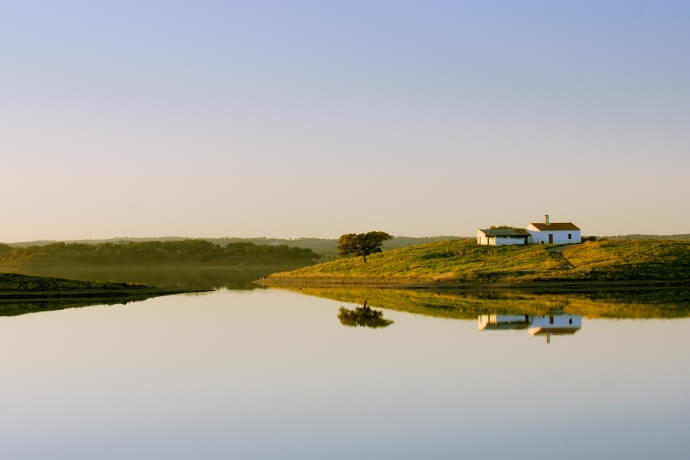
This brilliantly accomplished book tells the story of a family from Alentejo, spanning from 1910 to 1979, and portrays rural Portugal with its poverty, illiteracy, and submission. The bitter narrative takes us through the uprisings and occupations of farms in the early 20th century until the April Revolution, where the characters' hope is fleeting. Saramago's adept use of peasant language showcases his noble stylistic resources, splendid humor, and a singular talent for reconstructing environments, all of which put him among the most prominent contemporary writers. It is worth mentioning that the Nobel Prize-winning writer José Saramago is considered one of the greatest writers of the 20th century. He started his career as a journalist and later became a full-time writer.
The backdrop of this interesting narrative is the peaceful region of Alentejo, the largest and least populated region in Portugal, located in the south of the country, between the Tejo River and the Algarve. Free from traffic and the hustle and bustle you usually see in big cities, this tranquil, rural region is characterized by a slow pace of life, with cute whitewashed houses with colorful outlines, cork and olive trees, medieval castles, and beautiful vineyards and wineries. If you enjoy rural life, it is the perfect holiday destination! Plus, the region is famous for its delicious cuisine and internationally renowned wines. Also, there is a lot of archaeological, monumental, and architectural heritage to discover.
Castelo de Vide and Marvão, part of the Upper Alentejo region, are two of the many charming towns you can visit while in the region. In Castelo de Vide you will see that the town’s streets and heritage have kept their historical character since medieval times. The whitewashed houses, the flower pots, the medieval castle, the Jewish-related heritage, and the picturesque, peaceful streets are definitely worth the visit. In Marvão, a medieval town close to the Spanish border, you will be stunned by the splendid views over the charming castle! The Pousada, a historic hotel on a hill, features some of the best countryside views in town.
Évora, Monsaraz, and Estremoz are also beautiful towns that have plenty of amazing attractions for you to explore. Évora has been considered for decades the capital of the Alentejo. From the wide Praça do Giraldo, to the eerie Chapel of Bones or the many great restaurants scattered throughout the lovely historic center (which is a UNESCO World Heritage Site), Évora is sure to leave you enchanted with the Alentejo landscape. In Monsaraz, a true centuries-old gem, you can walk up the ramparts or head to the Alqueva Lake Dam, the largest artificial lake in Europe. Finally, in Estremoz, a lovely town built around a 13th-century castle, known as the “White City”, you can explore the marble quarries and discover the Marble Route, or visit the outstanding castle.
Either way you look, the Alentejo countryside will surprise you – the villages are as charming as they come, and the landscape, characterized by wide vineyards and serene plains, is a feast for the eyes!
Tango in Madeira – Jim Williams

In this intriguing book, placed after the World War I, Michael Pinfold attempts to save his family's wine business on Madeira Island. Meanwhile, the exiled Austrian Emperor fears for his life in a villa, afraid of being murdered, a lady crime novelist is stranded in Reid's Hotel, and George Bernard Shaw learns the tango with the hotel manager's spouse. When a stranger, Robinson, is murdered, Michael is drawn into an investigation by his manipulative best friend, Johnny Cardozo, the local police chief. Along the narrative, Michael also faces influence from Father Flaherty, a priest with doubtful political interests, and from his eccentric parent, and pursues a love affair with the police chief’s wife.
This book of crossed stories, full of intrigue, unfolds on the unique Madeira Island, located in the Atlantic Ocean, known for its spectacular natural beauty, rich history, and appealing atmosphere. The island boasts dramatic landscapes of towering mountains, lush forests, and sparkling ocean waters, all set against a backdrop of bright blue skies and warm sunshine. From hiking through the ancient levadas to relaxing on the golden sand beaches, there is plenty to do while on the island.
Also famous for its delicious wines, which have been produced for centuries using traditional methods, Madeira boasts beautiful vineyards located on steep terraced hillsides. The island's capital, Funchal, is a vibrant and colorful city that blends old-world charm with a modern feel. You can explore the city's many historic landmarks, art galleries, and museums, or wander through the bustling local markets and shops to discover local crafts and delicacies.
Madeira Island is a paradise for outdoor enthusiasts, with endless opportunities for adventure and exploration. The island's warm climate and mild temperatures make it an ideal year-round destination, with each season offering its own unique beauty and appeal. And there are plenty of charming towns to explore! The picturesque village of Santana is famous for its traditional A-frame thatched houses, which are a popular tourist attraction, and offers stunning views of the surrounding mountains and ocean; the historic town of Machico is one of the oldest on the island, dating back to the 15th century, and is home to many historic landmarks, including the Church of Nossa Senhora da Conceição and the Forte de São João Batista do Pico; the coastal town of Porto Moniz is home to some of the island's most dramatic natural attractions, including the Porto Moniz Natural Swimming Pools and the volcanic rock formations of the Fanal Forest; and the fishing village of Câmara de Lobos is located just a few kilometers from Funchal, making it a popular day trip destination. The town is famous for its colorful boats and picturesque harbor.
Each town offers a glimpse into the island's rich culture, stunning landscapes, and warm hospitality. It will surely surprise any traveler!
The High Mountains of Portugal – Yann Martel
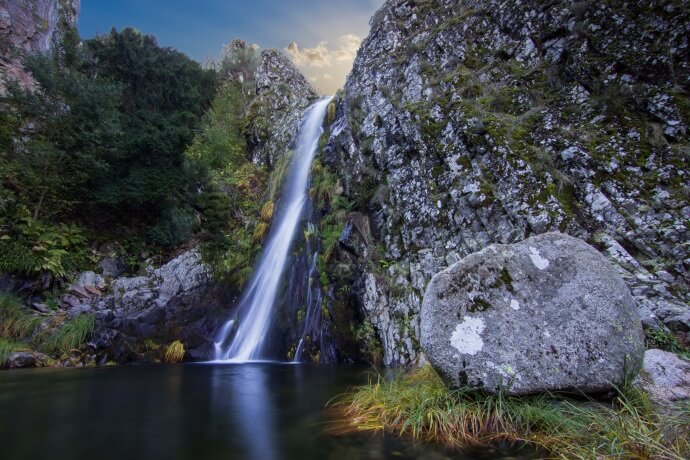
In 1904 Lisbon, Tomás discovers an old journal that reveals the existence of a valuable artifact. He embarks on a journey to find it, driving one of Europe's earliest cars. Thirty-five years later, a pathologist fascinated by Agatha Christie's murder mysteries becomes involved in Tomás's quest, and fifty years on, a Canadian senator grieving the loss of his wife arrives in his ancestral village in northern Portugal with a chimpanzee as his companion. The “High Mountains of Portugal” is a captivating blend of a quest, a ghost story, and a contemporary fable that explores love, loss, and the human soul on a road trip through Portugal.
The title of the book refers to the Serra da Estrela mountain range in northern Portugal, which is the setting for a significant part of the story. This mountain range is the highest in mainland Portugal, with peaks reaching over 6,500 feet, and it is known for its stunning natural beauty and diverse wildlife.
It is a breathtaking natural wonder that will captivate you with its rugged beauty and pristine wilderness. The majestic peaks are shrouded in misty clouds that lend an ethereal quality to the landscape, which has been attracting visitors from all over the world. At the heart of Serra da Estrela lies the Serra da Estrela Natural Park, a vast protected area that encompasses over 100,000 hectares. The vast expanse of snow-capped peaks, crystal-clear lakes, hidden waterfalls, rolling hills, and lush forests and valleys make Serra da Estrela a must-visit destination for nature lovers and a paradise for hikers! The region is also home to an array of flora and fauna, including rare species.
This appealing region is also known for its traditional mountain villages, cheese production, and winter sports. In winter, Serra da Estrela becomes a snow-capped wonderland, with the highest peak, Torre, often covered in a thick blanket of snow, offering breathtaking views of the surrounding landscape. Meanwhile, the glacial valley of the Zêzere River and its pristine lakes provide a stunning natural backdrop for hiking and outdoor activities.
The charming villages and historic towns that you will find along the way also offer a glimpse into Portugal's past. The city of Covilhã, once a center of wool production, is now a vibrant university town, home to several important historic sites, including the medieval Castle of Covilhã and the Santa Maria Church, a beautiful example of Gothic architecture. The village of Sabugueiro, perched on a hilltop, is known for its traditional architecture and beautiful views of the mountains. Manteigas, known for its traditional stone houses and picturesque streets, is also worth a visit.
The Piano Cemetery – José Luis Peixoto

This lovely book is a novel set in the working-class district of Benfica in Lisbon, telling the story of the Lazaro family who are cabinet-makers but aspire to be piano-makers. Their carpentry shop is situated in the district with a 'piano cemetery' at the back filled with broken-down pianos used for repairing pianos throughout the city. The novel narrates the hopes and fears of fathers passing on the baton to their sons, with the true story of the Portuguese marathon runner Francisco Lazaro interwoven into a rich narrative of love, betrayal, and dashed hopes. The novel offers beautiful imagery, true insight, and an instinctive understanding of families and their ways.
The city where the story unfolds requires little introduction. Lisbon, being the capital of Portugal and having plenty of outstanding highlights, is a very popular destination among travelers.
As you walk through the city streets, you will see that the sun-kissed buildings reflect the vibrant colors of its people and culture. The sound of trams echoes through its narrow alleys, where ancient churches and grand monuments stand alongside lively cafes and shops. The Tagus River, with its tranquil waters, flows lazily towards the sea, offering breathtaking views of the city's famous landmarks. At night, the city comes alive with the sounds of fado, the melancholic music that tells the tales of Lisbon's soul. With its diverse neighborhoods, Lisbon has plenty to offer for those lucky enough to visit.
In Alfama, the oldest neighborhood in Lisbon, you can wander through the maze-like alleys and winding streets, and enjoy the spectacular views from the Miradouros (viewpoints). The neighborhood is famous for its traditional Fado music, which can be heard in many of its restaurants and bars, and is also home to several important attractions, including the Lisbon Cathedral, the National Pantheon, and the São Jorge Castle.
In Bairro Alto, the bohemian quarter, you can soak up the lively atmosphere and indulge in the city's delicious cuisine. Known for its nightlife, it comes alive with bars, restaurants, and music venues. During the day, the neighborhood is a maze of narrow streets and colorful buildings. It is also home to several beautiful viewpoints, including the Miradouro de São Pedro de Alcântara and the Miradouro da Graça.
The Chiado quarter, with its elegant boutiques and cafes, is perfect for a leisurely stroll or a coffee break. This elegant and upscale neighborhood located between Bairro Alto and Baixa is indeed known for its boutique shops, art galleries, and cafes. It was once home to famous Portuguese writers and intellectuals, such as Fernando Pessoa and Eça de Queiroz and it continues to be a cultural hub of the city. It is also home to several landmarks, including the São Carlos National Theater and the Carmo Convent.
The Year of the Death of Ricardo Reis – José Saramago
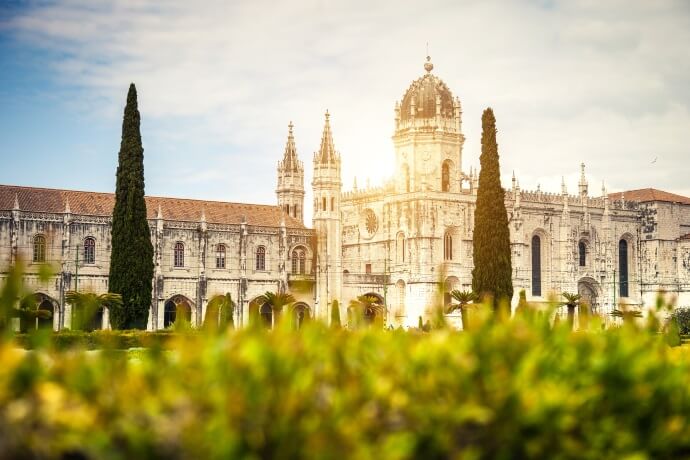
After spending 16 years working as a doctor in Brazil, Ricardo Reis returns to Lisbon. He yearns for Marcenda, who he believes is too high above him to attain, but he ends up sharing a bed with Lydia, a chambermaid from his hotel. In 1936, the political climate is tense, with the looming threat of Fascism, and his friend, poet Fernando Pessoa, visits him, dressed in the same suit he was buried in six weeks prior. They engage in deep conversations about various topics such as art, truth, philosophy, destiny, and love.
José Saramago wrote extensively about Lisbon in his novels. Lisbon was his hometown, and the city often served as a backdrop for his stories. In "The Year of the Death of Ricardo Reis” he portrays Lisbon during the 1930s, with its political and social climate. His descriptions of Lisbon in his books are often rich in detail and provide a vivid sense of the city. He portrays Lisbon as a place with a complex history and a vibrant cultural life.
In this interesting book, Saramago describes Lisbon's narrow streets, hills, and trams, evoking a sense of the city's character. He also writes about specific neighborhoods, such as Alfama, and includes references to Lisbon's monuments and landmarks, such as the Belém Tower, which is one of Lisbon's most iconic landmarks and a UNESCO World Heritage Site located in the Belém district. This 16th-century monument, also known as the Tower of St. Vincent, was once a fortress and a gateway to the city. It played a significant role in Portugal's maritime history!
In Belém, there are a lot of attractions steeped in history for you to explore. The Jerónimos Monastery, another UNESCO site, is a gorgeous example of Manueline architecture and houses the tomb of Vasco da Gama, the famous explorer, as well as the tombs of other famous Portuguese writers, such as Luís de Camões and Fernando Pessoa. It was built in the 16th century to celebrate Vasco da Gama's successful voyage to India. Considered one of the most important monuments in Portugal, this testament was funded by the wealth brought back from the East.
The Discoveries Monument, located next to the Jerónimos Monastery, is another significant landmark in Belém. This monument commemorates Portugal's Age of Discoveries and features several famous Portuguese explorers, including Henry the Navigator.
And let us remind you: Belém is also famous for its custard tarts, known as pastéis de Belém! These delicious pastries have been made since 1837 and are a popular treat for both locals and tourists. The recipe is a closely guarded secret, and the only place to try the original is at the Fábrica dos Pastéis de Belém.
In addition to its famous landmarks and pastries, Belém is also home to several museums, including the Museum of Popular Art, the National Museum of Archaeology, and the Berardo Collection Museum.



